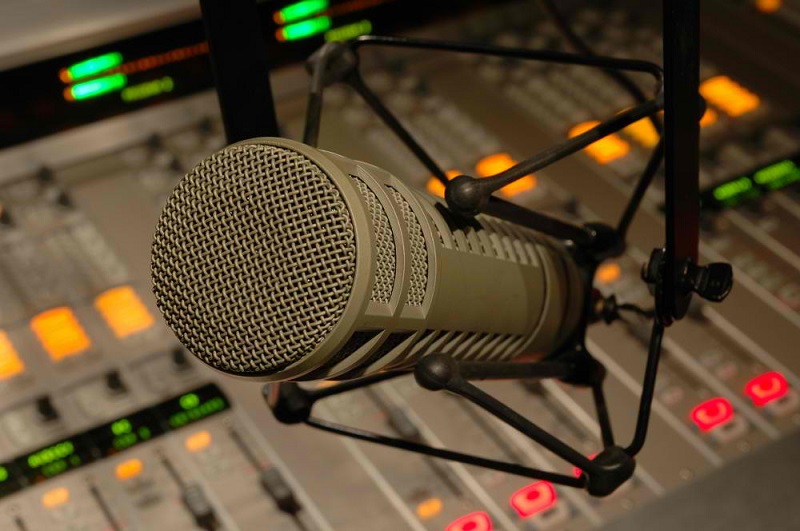This article will provide a description of the advertising on the radio, information on the means of radio advertising, their purpose, functions and features.
Radio is an electronic media outlet with low selectivity, affecting a wide audience. The radio station is a device or set of devices for receiving and / or transmission of radio waves. By the term “transceiver” as technical means, commonly understood as a transmitter and a transceiver technical means, as well as broadcast complex, i.e. a radio transmitter with associated equipment (studio, communication channels and power antenna for receiving and / or transmitting radio waves). The term “radio” as a means of mass information, commonly understood as the enterprise (institution) media, engaged in broadcasting. The “station” may not have their own technical facilities, and rent airtime from other broadcasters. As a media, station must be registered and licensed in the appropriate state institutions. Depending on the format and topics of the broadcast may be news, music, sports, educational and so on.
Radio is not a highly profitable sector of the advertising industry. Thus, in many economically developed countries of the world today, the number of commercial radio stations is much higher than the number of commercial television stations, but the total radio revenue is much less television revenue. This is because the radio as an industry is a local media with low overhead cost and therefore with low incomes. Thus, in many countries a significant proportion of small radio stations on the verge of profitability, as their main source of income are revenues from local advertising, often very limited. This is typical for countries with a developed system of commercial radio, and for the countries where leading positions are taken by public radio.
The Structure Of The Radio Industry
Types Of Radio Stations
Here are the most common methods for the labeling stations, depending on the characteristics of having a decisive importance for advertisers.
Coverage area:
- Local radio stations.
- Regional radio stations.
- National radio stations.
Broadcasting format:
- Music formats.
- Information formats.
- Combined formats.
- Specialized formats.
Broadcasting organization:
- Independent radio stations are, above all, numerous regional radio stations, which entered the market before the advent of large national radio.
- Radio stations included in the radio network are the local offices of major national radio stations. They translate the central radio program, occasionally interrupting her own production and local advertising. At the same time own, a radio program must comply with the general format of the central station.
As advertising media usually used on local and regional radio stations as well as the coverage of each of the stations depends on the power of the transmitter and from the radio network capacity (if the station is a network) that allows the advertiser to accurately plan the volume and quality of potential advertising impact on the target audience.
Types Of Mass Broadcasting
To date, we developed four basic types of mass broadcasting …
- News broadcasting: With this type of broadcasting, music broadcast on the air almost none. Usually it is cyclical newscasts with constant updating of information, as they become available, alternating advertising inserts. Sometimes news reports are added and short talk show.
- News and music broadcasting: With this type of broadcasting relation information and music, information is 60-70 percent to 30-40 percent against music.
- Music and news broadcasting: With this type of broadcast ratio, information and music respectively reversed 30-40 per cent and 60-70 per cent of the information of music.
- Music broadcasting: With this type of broadcasting of information, including short headings and news releases, not more than 10-20 per cent of airtime, and the rest of the given music.
To date, these forms of broadcasting are the basis of the structure of radio industry in developed countries.
The New Broadcasting Technology
The development of communication technologies and equipment led to the emergence of fundamentally new ways of broadcasting and means of signal delivery, among which in the first place, it may be noted …
1) Cable radio: Implements radio broadcast over cable television networks, providing high-quality sound in the absence of radio interference. The most widely used cable stations received in the US, where cable radio networks are transmitted mainly music programs, and the promotion of such services to subscribers television networks positioned as “radio for those who are tired of advertising”, i.e. the possibility of creating advertising communication on cable radio channels are now almost completely absent.
2) Digital radio: It represents transceivers system based on digital radio broadcast. It is assumed that the digital broadcasting gradually supplant the analog, however, unlike television, where conventional cathode-ray television receivers may be adapted to receive a digital video signal via analog-to-digital converters without substantial loss of image quality, the introduction of digital broadcasting require radio acquisition of new digital radios, i.e. substantial costs, which, according to some experts, the mass listener is not ready yet. However, digital radio has significant advantages over analog: high sound quality, the complete absence of interference, the ability to take an unlimited number of radio stations almost anywhere in the world.
3) Internet radio: Performs digital radio broadcast over the Internet, providing high-quality sound in the absence of radio interference. It is in its infancy, so to give any clear predictions about the models for its future development and promotional opportunities seems it is premature.
Aspect Broadcasting
Radio passed a complex way of evolution since its inception. Its main media strategy, which was formed during the radio the greatest popularity in the first half of the XX century, was determined by the fact that it was the first way of the mass organization of family and collective leisure. At the initial stage of the broadcast radio programs were created on the principle “all for all and for all”, and it was at this time that the term “broadcast”, signifying the omnipresence and all-embracing radio.
However, in the middle of the XX century, this strategy was intercepted by TV, where the mass audience began to leave, and with it the advertisers. Television showed advertisers new possibilities in the creation of a mass audience. Since advertising was (and still is) the only source of revenue for radio stations, advertising outflow made radio industry to seek new software and business strategies. The solution was found in the transition to the concepts of aspect radio; contribute to better meet the information and musical tastes of the audience.
Transition broadcasting to listener’s niche service concept was the beginning of the process of segmentation of a mass audience. Strong competition from television and the development of the advertising industry, the emergence of a growing diversity of music styles and subcultures caused defragmentation audience broadcast and the subsequent emergence of numerous formatted radio stations. The final transition to the radio strategy narrow formats due to a significant increase in the number of cars that were for personal use.
Today, almost all vehicles are equipped with radios, so the inhabitants of developed countries, in the life of the car that plays a significant role as a means of daily transportation, get much of the information from radio broadcasts. At present, almost all radio stations base their commercial policy on clear differentiation audience. That differentiation is gradually returned to radio audiences and with it the advertisers. Despite the fact that now the radio is not leading advertising vehicle, radio attracts advertisers accurate and comprehensible targeted at specific audience segments.
Broadcasting format characterizes the genre content, theme, style of presentation broadcast radio programming aesthetic norms, manner of leading programs, structuring program elements and other specific features of the organization transfers. Thus, the format – a set of genre, theme, program and other features, forming the concept of broadcast.
All broadcasting formats are divided into four main groups:
- Music formats.
- Information formats.
- Combined formats.
- Specialized formats.
Certain broadcasting format is the economic basis of radio industry, so the format is often determined by the marketing orientation of the radio. The choice of format is directly connected with the possibilities of the radio station to attract advertisers through the organization of specific audience segments. In this sense, the format implies a certain framework, conceptual station broadcasting mode, reflecting the preferences of a particular target audience.
Such common formats as “radio music”, “news radio”, “radio communication” means the main genre of the radio where every single format can be divided into others. The practice of developed markets shows that the basis of the activities of nearly all commercial radio stations is no more than 20 major formats. However, there are plenty of options for their implementation, depending on the specific national conditions, cultural and musical traditions of the country, the radio position in the national media.
Radio Audience
Audience most radio stations belong to the type of audiences with high target segmentation. As a rule, every commercial radio station is more or less exactly position able media interested in attracting a specific target audience. Therefore, the radio station have a very accurate picture of the nature and composition of its audience. In addition, the size and composition of the audience of a particular station regularly investigated using various techniques specific analytical services, so the advertiser, involving the advertising campaign or another radio station can establish a predictable and focused on a particular target group effective advertising communication. As a rule, consumers are not listening to a radio station, and selects an average of three to six. Therefore, in many cases, advertisers effective advertising campaigns on several radio stations in order to ensure that all target groups of consumers of the advertised goods or services.
As the results of numerous studies, each of the radio refers to one of four types of groups …
- Fans of the radio: Listen to a few stations, switching from one to another, have certain inclinations and preferences.
- Radio fans: Constantly listening to one or two radio stations are highly loyal to the selected station.
- Music lovers: Listen to music only certain genres, switching from station to station in search of favorite works.
- News lovers: Feel the constant need for information; listen to two or three radio stations, including radio and often for short periods.
Features Radio As A Channel Of Distribution Of Advertising
Planning and implementation of advertising campaigns on radio requires the advertiser knowledge of individual features of the radio, acting as an advertising medium. Radio on a number of parameters has many advantages over other media, but it may be limited. In some cases, radio advertising is extremely inefficient, due, primarily, to such factors as the inability to show the subject of the advertisement or non-representation of the object of advertising and audience perception. As part of the complex advertising campaigns radio advertising is effective primarily as an aid, particularly in conjunction with TV advertising and advertising in the press. Such a complex effect can significantly improve the performance indicators of advertising campaign in comparison with the impact of television is only the means and / or the press.
Advantages and Disadvantages Of Radio Advertising
| ADVANTAGES | DISADVANTAGES |
| Radio allows you to reach a certain audience segments using well-defined formats. Radio advertising can be directed to the listeners of a particular gender, age, occupation, income level or education. | Fleeting, short transmission time of advertising messages as compared to other advertising distribution channels, the low concentration of listeners (people listen to the radio, doing other things). |
| Radio advertising is the shortest period of preparation in comparison with other media. This allows advertisers to radio as much as possible to adapt to the peculiarities of the local market, news, weather, and other variable factors. In this case, the advertiser can respond quickly to certain situations and contribute to your ad text changes and additions. | The lack of visual range and limitations associated with only the sound representation of the goods or services. |
| Radio is the least expensive for the advertiser of all media advertising media. Because of the relatively low cost of providing radio advertising ester may be repeated numerous times with a relatively low cost. The cost of production of commercials and low. | Total advertising broadcast congestion. Advertising messages are broadcast on the radio in large quantities and are replaced fairly quickly, so students miss many advertisements, while others forget listening to them only partially. |
| Using sound to create mental images. Radio has the ability to stimulate the imagination of listeners, combining sounds, words, intonation and a variety of audio effects. | In the production of commercials using an actor and announcer radio resources employees, so the advertiser runs the risk that his announcement will be heard on the air in the same way as the other ads that station. Such messages are coming one after another; significantly reduce the level of the listening perception. |
| Radio is the most common media device, characterized by high mobility can be operated without special infrastructure and clear any audience regardless of the level of literacy. Radio installed in a variety of technical devices – radios, alarm clocks, TV, music, mobile phones, portable players. A significant part of the radios installed not only in homes and public areas, but also in all forms of transport. | The lack of monitoring of radio and high-quality media measurement, so the effectiveness of the advertising campaign is difficult to analyze. |
| Radio has an ideal environment for the transmission of frequently repeated messages. The average radio listener listens to the radio for more than three hours a day, so even regular advertising schedule allows him to remember this or that advertising appeal. This ability to repeat radio advertising a large number of times, motivating consumers to purchase the product or service is especially important for advertisers. Total costs of advertisers at the same time are relatively low, and the program policy of many radio stations usually allows providing high output advertising broadcast frequency. | The low level of attention of the audience. Listeners perceive many forms of radio as a musical or entertainment background. |
| Broadcasting covers a vast territory, addresses the audience at any time, and is also an ideal means to reach people in a car. | Lack of uniform standards of interaction with radio advertisers. |
Forms Of Radio Advertising
There are several common forms of radio advertising offered advertisers the majority of radio stations. Although the search for new effective forms of radio advertising is ongoing, traditional and proven promotional tools occupy a leading position among the most popular …
1) A radio spot in the ad unit: Advertiser buys space in an ad unit, which is broadcast in commercial breaks in a program or between programs. During purchased time (10, 15, 20, 30 and so on up to 60 seconds) the commercial broadcast provided by the advertiser. Number of broadcasts and their time and place in the roller block (beginning, middle, and end) are set in the final version of the media plan, which is agreed by the parties in the process of signing a contract for the purchase (sale) of advertising time.
2) Sponsorship of radio programs: The program, broadcast by the radio station may be completely or partly carried on money sponsor who receives a certain amount of time for placing their ads. In some cases, the sponsor receives and other promotional opportunities: advertisement sponsor and / or the object of advertising leading the program, plot placement of the sponsor and / or the object of advertising, integration site advertising the program, sponsor participate in interactive projects, the joint organization of the sponsor and radio public events and so on. In contrast to the ad unit, a sponsorship message, as a rule, it is a full-fledged part of the program. Sponsorship filling depends on the timing, subject matter and content of the sponsored programs on the radio.
3) Sponsorship of radio broadcasts: Some prestigious reportage programs with predictable rated (e.g. sports matches), the practice of sponsorship broadcasting, which implies that the sponsor pays all expenses for the purchase of broadcast rights and ensure its support in exchange for a certain time to place his advertisement. In cases where the interest in the event is very high (as well as the price of broadcast rights), in the sponsorship pool combines a number of companies that are not direct competitors, which is divided between advertising time according to their contribution to the sponsorship package.
4) Spot radio advertising: Advertiser buys time for broadcast commercials in one particular program that shared ad unit.
5) References: Single or multiple references to the name of the program leading advertiser and / or advertising object.
6) Interview in the studio: Themed interviewing information and advertising, which is leading the program takes from the advertiser or its representative.
7) Radio announcements: Advertising information, which is read out a speaker in the advertising information section. This type of radio advertising is aimed at advertisers with small budgets and offers on local radio stations.
8) Radio log: Thematic broadcast information and advertising.
In the end, here we have describe all the possible information about radio advertising. We are going to describe about other advertising media as well. Keep support us by your valuable comments.
Advertising Media:
“Television Advertising: All You Need To Know About TV Advertising“
“Radio Advertising: All You Need To Know About Radio Advertising“
“Press Advertising: All You Need To Know About Print Media“
“Internet Advertising: All You Need To Know About Online Advertising“
“Outdoor Advertising: All You Need To Know About Outdoor Advertising“
“Transit Advertising: All You Need To Know About Transit Advertising“
“Print Advertising: All You Need To Know About Print Advertising“







